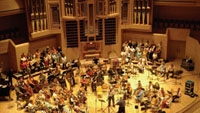Surround recording for TV
Across the globe, HD transmissions are becoming more prevalent for both major, local and cable networks. The number of households with home theater systems continues to increase, causing viewers to demand broadcast content that equals their DVD experience.

This home theater revolution is resulting in surround sound being integrated into everything from major award shows to local newscasts, while at the same time leading broadcasters to focus as much time into audio technologies as video.
As broadcasters are starting to realize, selecting a means to record surround audio is a little more involved than at first thought. Up to this point, the majority of surround has been captured using complex, multi-mic setups, but multiple cables and mics can be cumbersome to transport to on-location shoots and take time to calibrate.
To make the switch easier for their crew, more broadcasters are turning to surround microphones to record their production's audio. These mics function on the premise of recreating what a viewer experiences on-site, so audio is captured from one centralized location.
If sound was being picked up from all over the venue, as in a multi-mic setup, too many variables can affect the sound in terms of the mic correlation to each other. Furthermore, the multi-mic setup does not recreate what ones ears hear, because ears are not spread out hundreds of meters apart. When paired with the picture, there are too many variables in time and space that will change the audio image received, producing a less than realistic viewing experience.
Another obstacle broadcasters face when selecting surround technology is that although surround sound has been around for a while, there are still few manufacturers who actually have developed microphones to record in surround. Even between manufacturers, the methods used to capture surround vary.
When selecting a surround mic to use for broadcast, two major factors to consider are the amount of audio channels being recorded and mic construction.
Channel types
Within the consumer market, there are several ways viewer's home theater systems decode surround, so the number of audio channels a mic captures becomes a key consideration. The most common of the surround configurations is the 5.1 channel: left, right, center, sub (LFE), left surround and right surround. There are some variations to this setup, which usually include over-the-top speakers. Some manufacturers have incorporated this speaker variation into their mic design.
Although 5.1 is the current norm, 6.1 channels are becoming almost as common. Microphone manufacturers have picked up on this trend and have developed mics that can capture in 6.1. However, for the majority of on-location and ENG situations, as well as daily broadcasts, 5.1 channels will be sufficient.
For larger, high-profile productions, the channels will enhance the end result — even if the viewer does not have the speakers for 6.1 sound. The additional channels can be mixed into the typical 5.1 setup. The majority of surround microphones on the market are made to record in 5.1 channels to accommodate speaker placements within any post-production studio or home theater.
Mic types
There are several different methods in which the actual surround microphone captures and interprets the sound. The majority of microphones run on the premise of using multiple pickup patterns to create a realistic sound capture. Combinations of cardioid and omnidirectional pickup patterns are the most commonly used in these types of microphones.
Because the microphones are so close together, there is a lot happening in terms of sound from one direction hitting multiple microphones at the same time. It is this overlapping of sounds that manufacturers are setting to harness to create the most realistic soundscape possible.
Along with multiple pick-up patterns, some microphones also use a processor to create 5.1 channels of audio. If the mic is capturing with four mics or fewer, the signal will need to be processed to create the additional channel. Across the models on the market, there are two main mic structures that are the most prevalent: the encapsulated multi-mic and the tree (also called mounting bar) setup.
Encapsulated multi-mic design
One of the most popular and user-friendly of the surround microphone models is the encapsulated multi-mic structure. In this design, all mic capsules are contained within one structure, eliminating the need for adjustment of the mic's directionality. These mics function similarly to a single-channel microphone. Little training is required for crews to learn how to use the mic to its fullest potential.
There are several variations of how the mic is structured and operates. One design has an elliptical encasement to recreate the acoustical shadow of the human head. Each has six or more mic capsules enclosed in the structure, which capture audio from the separate directions. The elliptical shape helps to bring the audio to the point of the encasing where it acts like a nose, separating left channels from right. It also directs the center channel into the closest proximity to whatever is being captured, resulting in a soundscape that draws the viewer in. All channels captured by these designs can be sent directly to a surround recorder or directly to a monitor. Some of the models have an additional top channel to add height to recordings.
For example, if one is recording sound in a church that has high ceilings and there is an organ performance at eye level, the reason that church sounds fantastic isn't because of what's happening at eye level, but what happens above in the vaulted ceilings of the church. This channel helps to capture that experience. The compact size and short set-up time make this mic ideal for on-location and ENG situations.
A different take on the encapsulated design is a mic with a spherical shape with two mics contained within the sphere and two figure-eight microphones placed directly outside the sphere. Like the elliptical design, the shape is intended to create an acoustic shadow similar to that seen in the human head. The additional mics are intended to recreate sound behind your head and much like as if the microphones were close to one's head. All four channels are fed into a processor, where a fifth channel, the center channel, is obtained.
Because of its small size and minimal setup, this product also lends itself to on-location recording. Although most of the guesswork and calibration have been pre-set, calibration of the external microphones is still required. You will have to gauge the skill set of your audio crew to see if this is a viable option.
In addition to mics that try to recreate the acoustics of the human head, other mics on the market use multiple mic capsules but keep a shape typically seen in a single-channel microphone. This design captures four channels of audio, which are directed to the front, back, left and right. By feeding each of these channels into a processor, a 5.1 recording results. Like the other encapsulated mics, this design is easy to set up and will hold up in an ENG situation. The processor will add additional cost.
Tree or mounting bar design
Surround microphones that work off a tree or mounting bar structure are basically expanding on stereo microphone setups. The actual metal structures of these mics vary, resembling a horseshoe, a starburst or parallel lines. The goal of these structures is to use the varying pickup patterns and directionality of the microphones to create 3-D sound.
These structures contain three or more microphones that need to be properly distanced away from each other on the metal structure as well as directed to the right point in the venue.
The future of surround
Surround has already caught on more than early estimates predicted. As the use of surround continues to increase, we should expect to see standardization of the amount of channels captured, encoded and decoded.
Prime-time content on the major networks is already starting to mirror and surpass the complexity of major motion pictures, resulting in broadcasters requiring more than the current norm of 5.1. Decoders with additional channels are already on the market, so it is not too far off to predict the increase in the standard number of surround channels in coming years. Some manufacturers are anticipating the change and have already increased the number of channels in their microphone designs.
To fulfill this need for surround content in television broadcasts, most media outlets are going to need to turn to surround microphones. Unlike a large film set where the time is available for calibration and setup, many media outlets work under short time frames and will require technologies that are time-efficient. Surround microphones, whether they are encapsulated or tree designs, are helping to take the guesswork out of recording in surround.
With the demand continuing to grow, we should expect to see an increase in manufacturers with surround technologies, much like we have witnessed with the increase in HD video technologies.
Up to this point, the majority of audio content for broadcasts has been captured by a shotgun microphone attached to a camera. Though there are few choices when it comes to selecting a microphone that can be directly attached to a camera, as surround becomes the norm, items on the market that are compact enough to be attached to a camera will continue to increase. We may even start to see the encoding and capturing technologies incorporated into the cameras themselves.
Michael Godfrey is president and founder, and Jonathan Godfrey is CEO of Holophone.
Get the TV Tech Newsletter
The professional video industry's #1 source for news, trends and product and tech information. Sign up below.
